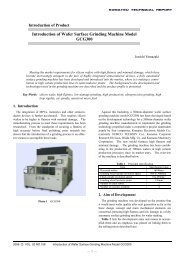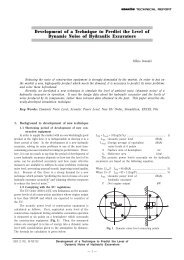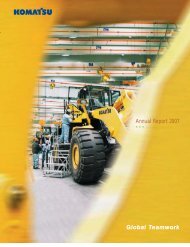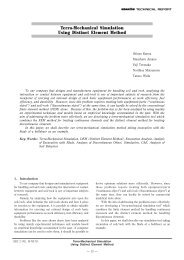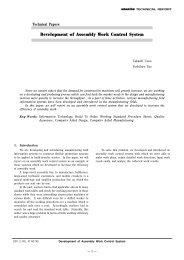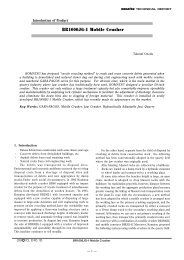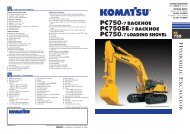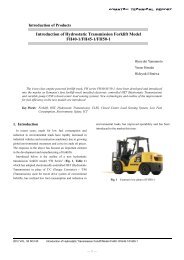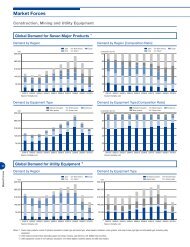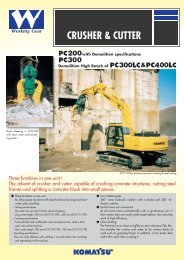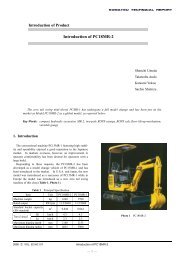Introduction of GD755/GH320 GALEO Series Snow ... - Komatsu
Introduction of GD755/GH320 GALEO Series Snow ... - Komatsu
Introduction of GD755/GH320 GALEO Series Snow ... - Komatsu
Create successful ePaper yourself
Turn your PDF publications into a flip-book with our unique Google optimized e-Paper software.
<strong>Introduction</strong> <strong>of</strong> Product<br />
<strong>Introduction</strong> <strong>of</strong> <strong>GD755</strong>/<strong>GH320</strong> <strong>GALEO</strong> <strong>Series</strong><br />
<strong>Snow</strong>-Removal Motor Graders<br />
Shinji Iguchi<br />
GD705A-4A snow removal motor grader, which has been marketed since 1983, and <strong>GH320</strong>-2 highspeed<br />
compacted-snow removal grader, which was developed and marketed after 5 years <strong>of</strong> joint study as a<br />
development project <strong>of</strong> the Ministry <strong>of</strong> Construction that started in 1990, were fully model-changed after 22<br />
years and 15 years, respectively, to incorporate advanced technologies and thus meet the needs <strong>of</strong> new age.<br />
They are marketed as models <strong>GD755</strong>-3 and <strong>GH320</strong>-3. This report introduces these new models.<br />
Key Words: Motor Grader, <strong>GD755</strong>, <strong>GH320</strong>, <strong>Snow</strong> Removal, Product <strong>Introduction</strong>, <strong>Snow</strong> Removal<br />
Attachment, Variable Horsepower, Dual Mode Transmission, Tier2 Emissions Regulation,<br />
CLSS Hydraulic System, Hydraulic Control Brake System, Steering System with Quantity<br />
Amplifier<br />
1. <strong>Introduction</strong><br />
<strong>Komatsu</strong> GD700 <strong>Series</strong> (blade length 4 m class) motor<br />
grader shares almost 100% in the snow removal conducted<br />
by government agencies in Japan, fulfilling the social mission<br />
<strong>of</strong> securing the means <strong>of</strong> transportation in winter as<br />
the principal machines for snow removal <strong>of</strong> roads.<br />
Though Japanese market is not so large, i.e. approximately<br />
70 units per year, it is indispensable for DB including<br />
the sale <strong>of</strong> spare parts and is highly reputed by government<br />
agencies.<br />
Taking the opportunity <strong>of</strong> complying with Tier II emissions<br />
regulation , <strong>Komatsu</strong> developed new models that incorporate<br />
new features to meet the needs <strong>of</strong> new age . Following<br />
are the overview <strong>of</strong> the new models (Photo 1).<br />
Photo 1 <strong>GD755</strong> Overall view<br />
2. Development Concept<br />
Concerning quality, medium size GXX series motor<br />
graders (GD655/GD675/GD555) are already at the highest<br />
level in the world, and their development concept was applied<br />
also to the new models.<br />
However, because <strong>of</strong> full model change after 20 years,<br />
there was a problem <strong>of</strong> how to minimize the increase <strong>of</strong><br />
cost, which is resulted from increasing the performance,<br />
and provide new models at reasonable prices.<br />
Our basic concepts are as follows:<br />
(1) Compliance with Tier II-emissions regulation<br />
Environment-friendly clean engine and low noise<br />
(2) Improved operability<br />
Easy operation by automatic transmission (automatic gear<br />
shifting)<br />
(3) Improved work performance<br />
Increased operation speed by variable horsepower<br />
(4) Measures to improve reliability and safety<br />
Full hydraulic control brake system, O-ring face seal, the<br />
employment <strong>of</strong> DT connector, emergency steering as standard<br />
(5) Improved maintainability and serviceability<br />
Employment <strong>of</strong> machine monitoring system, the extended<br />
engine oil change interval , and provision <strong>of</strong> KOMTRAX as<br />
option<br />
(6) A wide variety <strong>of</strong> snow removal attachment<br />
A wide variety <strong>of</strong> snow removal attachment that meets<br />
the snow quality <strong>of</strong> individual district
In order to minimize the increase <strong>of</strong> cost, unlike medium<br />
size models, the power train was configured such<br />
that the transmission is arranged at frontward portion <strong>of</strong><br />
the machine to simplify the system configuration.<br />
As a result, it became possible to install a large fuel<br />
tank (416 liter) at lower portion <strong>of</strong> the machine , which<br />
facilitates the refilling <strong>of</strong> fuel (Fig. 1).<br />
Torque converter<br />
<strong>GD755</strong>/<strong>GH320</strong><br />
Hydraulic oil tank<br />
GD655<br />
Hydraulic oil tank<br />
Damper<br />
FAN<br />
E/G<br />
R/D<br />
T/M<br />
Fuel tank<br />
Though the same concept <strong>of</strong> medium size GXX<br />
is applied, the power train configuration is<br />
changed such that transmission is arranged at<br />
frontward portion <strong>of</strong> the machine (for medium<br />
size, arranged at rearward portion) to simplify<br />
the configuration and enable refilling fuel by<br />
standing on the ground.<br />
Fig. 1 Comparison <strong>of</strong> power train configuration<br />
<br />
To improve safety during on-road traveling, the brake<br />
control system was changed from pneumatic to full hydraulic<br />
control type, and O-ring face seal was employed for the<br />
hydraulic piping.<br />
To meet the demand for high-speed snow removal,<br />
<strong>GD755</strong> employs the variable horsepower (VHP) system to<br />
improve snow removal performance to a large extent, compared<br />
with conventional models.<br />
Especially advanced is the technology <strong>of</strong> automatic<br />
transmission and direct drive /torque converter mode selection<br />
that uses a transmission with lockup torque converter<br />
.<br />
The system that allows operator to freely select between<br />
direct drive and torque converter modes is the unique technology<br />
that no company other than <strong>Komatsu</strong> possesses in<br />
the world.<br />
3. Main Features<br />
3.1. Compliance with Tier II emissions regulation<br />
3.1.1 SAA6D125E-3 engine is installed to comply<br />
with Tier II emissions regulation<br />
(1) SAA6D125E-3 engine, which is equipped with a large<br />
capacity fuel feed pump, is installed to comply with Tier II<br />
emissions regulation and improve serviceability.<br />
In addition, for <strong>GD755</strong>, two types <strong>of</strong> horsepower curve (220<br />
HP and 250 HP) are incorporated in the engine controller<br />
to implement VHP.<br />
(2) The engines <strong>of</strong> <strong>GD755</strong> and <strong>GH320</strong> are configured with<br />
the same application to facilitate interchangeability.<br />
3.2 Improved operability<br />
3.2.1 Employment <strong>of</strong> transmission with lockup<br />
torque converter<br />
(1) Under the same concept as medium size GXX series, the transmission<br />
with lockup torque converter that is already highly reputed<br />
in the USA market is installed (Fig. 2).<br />
F/D<br />
Hi/Lo clutch<br />
Used also as inching clutch<br />
Fig. 2 8th speed transmission with lock-up<br />
torque converter<br />
Concerning the transmission <strong>of</strong> motor grader, European<br />
machines employ torque converter system while USA and<br />
Japanese machines employ direct drive system.<br />
There are arguments pro and con regarding which <strong>of</strong> the<br />
two systems excels in operability. So, for GXX series, it was<br />
made possible to change over between torque converter and<br />
direct drive modes.<br />
In Japan, experienced operators tend to prefer direct drive<br />
mode, while young operators prefer torque converter mode.<br />
Concerning snow removal, the operators who operate only<br />
in winter (for 3 months) are increasing. So, torque converter<br />
system, which is easy to operate, is advantageous.<br />
For this time model change, “improved operability” <strong>of</strong> transmission<br />
is the key <strong>of</strong> our “unique and unrivaled product”.<br />
(2) In torque converter mode, medium- and higher speed<br />
stages are made to have the automatic gear shift function<br />
to relieve the fatigue <strong>of</strong> operator during snow removal.<br />
Operator will be tired out if he must perform both complicated<br />
blade control and transmission control on a road on<br />
which many ordinary vehicles run (Fig. 3).<br />
Torque converter mode and automatic gear shift function<br />
relieve the operators’ work <strong>of</strong> transmission control and thus<br />
improve safety.<br />
Operator not only operates the<br />
travel lever but also controls<br />
individual actuator according to<br />
road condition.<br />
Blade lift (right)<br />
Circle rotation<br />
Leaning<br />
Steering<br />
Articulate<br />
Blade lift (left)<br />
Drawbar shift<br />
Power tilt<br />
Blade shift<br />
Fig. 3 Grader operation
(3) A mechanical damper is built in the transmission. For<br />
this, <strong>Komatsu</strong> developed a unique damper and incorporated<br />
it in the transmission.<br />
Because backbone type, which directly connects engine to<br />
transmission, is employed, mechanical damper is used to<br />
improve reliability, taking the temperature rise in the housing<br />
into consideration.<br />
3.2.2 Hydraulic system<br />
(1) The integrated CLSS system, which controls blade, brake<br />
and steering by a single variable displacement piston pump,<br />
is employed (Fig. 4)<br />
as described before can remember the knacks <strong>of</strong> operation<br />
in a short time.<br />
3.2.3 Reduction <strong>of</strong> noise in operator cab<br />
Front frame mounted cab is employed to separate the<br />
cab from engine room, transmission and hydraulic pump<br />
and thus reduce the noise level in the operator cab (Fig. 6)<br />
<strong>GD755</strong>-3/<strong>GH320</strong>-3<br />
Noise at operator's ear : 79dB(A)<br />
Noise<br />
GD705A-4A/<strong>GH320</strong>-2<br />
Noise at operator's ear : 86dB(A)<br />
Noise<br />
Cylinders and motor <strong>of</strong><br />
each work equipment<br />
T/M<br />
Engine<br />
T/M<br />
Engine<br />
DB12 control valves<br />
with unload valve<br />
F/D<br />
F/D<br />
Priority valve +<br />
Brake valve<br />
Necessary<br />
flow rate signal<br />
Pp pressure<br />
Pressure<br />
reducing valve<br />
Flow control by the spool<br />
corresponding to each cylinder<br />
Steering<br />
ACC<br />
Brake<br />
Fig. 6 Noise level in cab<br />
3.2.4 Improved front/working visibility<br />
GXX cab with large glass area is employed to improve<br />
visibility by 15% (Fig. 7).<br />
<strong>GD755</strong>-3/<strong>GH320</strong>-3<br />
Visibility improved by 15%<br />
GD705A-4A/<strong>GH320</strong>-2<br />
LS pressure<br />
Secure necessary flow rate even at low<br />
engine speed (piston pump)<br />
Necessary flow rate signal<br />
Fig. 4 Hydraulic system<br />
With conventional models, because gear pump is used, the<br />
speed <strong>of</strong> blade greatly changes with engine speed. For the<br />
new models, because the speed change <strong>of</strong> blade is limited,<br />
from low to high engine speed, by means <strong>of</strong> piston pump,<br />
operators can control blade with the same feeling throughout<br />
the work. Thus easy operation is achieved (Fig. 5).<br />
<strong>GD755</strong>-3Y<br />
GD705A-4A<br />
Visibility in R19m : 71.4% Visibility in R19m : 61.8%<br />
Fig. 7 Comparison <strong>of</strong> visibility<br />
<strong>GD755</strong>-3<br />
<strong>GH320</strong>-3<br />
GD705A-4A<br />
<strong>GH320</strong>-2<br />
Blade speed<br />
Photo 2 GXX cab<br />
Low idle speed<br />
Engine speed<br />
Rated speed<br />
Fig. 5 Work equipment speed<br />
(2) The opening area <strong>of</strong> DB12 control valves is made proportional<br />
to the areas <strong>of</strong> cylinder head and bottom to keep<br />
the speed <strong>of</strong> blade constant, from low to high engine speed.<br />
In addition, the constant ratio flow dividing function assures<br />
that downstream side control valve is surely operated<br />
also when multiple blade control levers are operated simultaneously.<br />
Thus, the operators who work only in winter
3.3 Improved working performance<br />
3.3.1 Variable horsepower (VHP) ...... <strong>GD755</strong><br />
(Fixed horsepower for <strong>GH320</strong>)<br />
For the purposes <strong>of</strong> reducing fuel consumption and extending<br />
the service life <strong>of</strong> tire, variable horsepower is employed<br />
for <strong>GD755</strong>.<br />
The engine controller has two horsepower curves, or<br />
Hi (250 HP) and Lo (220 HP), and select the Lo curve for<br />
low travel speed stages and the Hi curve for high travel<br />
speed stages through interaction with the transmission controller.<br />
The curve for low travel speed stages aims at reducing<br />
fuel consumption and the wear <strong>of</strong> tire due to slip.<br />
The curve for high travel speed stages aims at improving<br />
snow removal speed to increase production as well as improving<br />
acceleration performance when traveling between<br />
job sites. (For details regarding variable horsepower, refer<br />
to the “Introdution <strong>of</strong> Product : GD655”, KOMATSU TECH-<br />
NICAL REPORT, January 2001.)<br />
Fig. 8 shows the result <strong>of</strong> the snow removal type test that<br />
was performed by the Japan Construction Mechanization<br />
Association in Ebetsu City in Hokkaido.<br />
Compared with conventional model GD705A, <strong>GD755</strong> showed<br />
1.4 times higher snow removal performance.<br />
<br />
<br />
<strong>Snow</strong> removal capacity<br />
<br />
<br />
<br />
<br />
Legend <strong>Snow</strong> removal with blade<br />
Compacted snow removal<br />
<strong>GH320</strong>-3<br />
<br />
<strong>GH320</strong>-2(Current model)<br />
<br />
<strong>GD755</strong>-3Y<br />
<br />
Smaller classs graders Fresh snow removal<br />
<br />
<br />
GD705A-4Y(Current model)<br />
<br />
<strong>GH320</strong>-2(Current model)<br />
<strong>GD755</strong>-3Y<br />
<br />
Compacted<br />
snow removal<br />
<br />
<br />
GD705-4Y(Current model)<br />
<br />
<br />
<br />
<br />
<br />
<br />
Engine horsepower <br />
Fig. 8 <strong>Snow</strong>-removal copacity<br />
3.4 Measures to improve reliability and safety<br />
3.4.1 Brake control system<br />
Full hydraulic control brake system is employed to improve<br />
reliability and maintainability.<br />
While conventional models use pneumatic control system,<br />
for the model-changed machines , full hydraulic control<br />
brake system is employed.<br />
With pneumatic control system, even if a dryer is<br />
equipped, it is inevitable that dew condensation in piping<br />
and dust contained in the air have an influence on equipment.<br />
Using full hydraulic control system, we succeeded in<br />
improving the reliability <strong>of</strong> equipment and relieving the work<br />
necessary for tank internal maintenance.<br />
<br />
<br />
3.4.2 Fuel tank<br />
Fuel tank is arranged at lower portion <strong>of</strong> the rear frame<br />
to enable the refilling <strong>of</strong> fuel by standing on the ground,<br />
taking the safety during refilling into consideration (Fig.<br />
9).<br />
With conventional models, it is necessary for operator<br />
to ride on the tandem drive case with the nozzle in hand to<br />
refill fuel. However, the tandem drive case easily gathers<br />
snow or mud, which freezes in winter to cause the danger<br />
<strong>of</strong> operator’s slipping. The refilling by standing on the<br />
ground assures the safety during refilling.<br />
<strong>GD755</strong>-3<br />
GD705-4A<br />
Slippery due to snow and mud<br />
Fig. 9 Comparison <strong>of</strong> fuel refilling<br />
3.4.3 Emergency steering<br />
Orbit-roll with quantity amplifier is employed to enable<br />
temporarily steering if engine stops (Fig. 10).<br />
Orbit-roll<br />
Dynamic<br />
signal line<br />
Control spring<br />
Return<br />
line<br />
Priority valve<br />
Pilot relief valve<br />
(for steering circuit)<br />
Steering cylinder<br />
Metering system<br />
(Gerotor)<br />
LS line<br />
Feed<br />
line<br />
Q-Amp Adjust oil flow rate according<br />
to the rotation <strong>of</strong> Gerotor Not work<br />
during emergency steering<br />
Control orifice<br />
Input control<br />
Control spool<br />
To work equipment<br />
Fig. 10 <strong>GD755</strong>/<strong>GH320</strong> steering circuit<br />
During normal operation, the Q-Amp circuit amplifies<br />
according to the rotation <strong>of</strong> the Gerotor <strong>of</strong> the orbit-roll to<br />
supply necessary flow rate to the system.<br />
On emergency, steering is controlled by the flow rate supplied<br />
from the Gerotor.<br />
3.4.4 Other measures<br />
(1) O-ring face seal is employed in the hydraulic system<br />
No oil must leak onto the road on which ordinary vehicles<br />
run. To assure this, seal was changed to O-ring face seal to<br />
further improve reliability.<br />
(2) DT connector employed in electrical systems<br />
To minimize the influence <strong>of</strong> snow-melting chemicals spread<br />
on the road or the snow fumed up in the air, DT connector<br />
with high sealing property is employed.
3.5 Improved maintainability and serviceability<br />
3.5.1 Machine monitoring system<br />
A 16-digit x 2-line machine monitoring panel is arranged<br />
in the steering post panel to improve maintainability (Photo<br />
3).<br />
<br />
(1) Service meter and cumulative running distance<br />
(2) Action code display<br />
. Machine condition / Instruction <strong>of</strong> maintenance<br />
(3) Error code display<br />
(4) Service function<br />
. Real-time monitor<br />
. Engine cylinder reduction mode<br />
. Adjusting function<br />
. Option selecting function<br />
. Forcible low idle fixing function<br />
. Torque converter stall function<br />
Fig. 12 shows how many times an operators operates<br />
the blade control levers during snow removal work.<br />
Most <strong>of</strong> the operations done are the lifting and lowering <strong>of</strong><br />
blade. It is clear from this graph that the load <strong>of</strong> operator<br />
will be greatly relieved if this operation is automated.<br />
This system eliminates the left/right blade lift/lower operation,<br />
relieving the fatigue <strong>of</strong> operator and improving the<br />
efficiency <strong>of</strong> snow removal.<br />
manipulation<br />
times per hour<br />
(times/hour)<br />
300<br />
200<br />
100<br />
Right blade lift<br />
Manual operation unnecessary<br />
during snow removal due to<br />
automation<br />
Fig. 12 Manipulation times per snow-removing hours<br />
Left blade lift<br />
Leaning<br />
Control lever<br />
Circle<br />
Photo 3 Monitor panel<br />
3.5.2 KOMTRAX<br />
Because individual regional maintenance <strong>of</strong>fices <strong>of</strong> the<br />
Ministry <strong>of</strong> National Land and Transport have their own<br />
operation management system, KOMTRAX was made to be<br />
an option.<br />
3.6 A wide variety <strong>of</strong> snow removal attachment<br />
(option)<br />
3.6.1 Combined automatic blade control<br />
The combined automatic blade control system, which<br />
automatically controls the blade cutting angle and blade lift<br />
cylinder force according to the information sent from the<br />
vibration sensor mounted on blade so that no residual snow<br />
is left on road and maximum efficiency is achieved, is provided<br />
as an option (Fig. 11).<br />
(For details regarding the system, refer to KOMATSU<br />
TECHNICAL REPORT, February 2002.)<br />
Stroke sensor<br />
Controller<br />
(computer)<br />
Solenoid valve<br />
Pressure senser to measure<br />
blade cylinder force<br />
Hydraulic oil to cylinder<br />
Sensor signal<br />
Touch panel<br />
Wheel rotation<br />
sensor<br />
Vibration sensor<br />
Cutting angle<br />
Propulsive<br />
sensor<br />
angle sensor<br />
Touch panel<br />
Lift lever sensor/<br />
Power tilt lever sensor<br />
Controller (computer)<br />
Wheel rotation sensor<br />
Fig. 11 Combined automatic blade control<br />
Fig. 13 shows the result <strong>of</strong> operation survey that was<br />
performed in Hokuriku district. It was reported that work<br />
speed increased by 18% compared with manual blade control<br />
, and by 7% compared with conventional blade control<br />
(with the system described in 3.6.7)<br />
Frequency ratio (%)<br />
45<br />
40<br />
35<br />
30<br />
25<br />
20<br />
15<br />
10<br />
5<br />
0<br />
Example <strong>of</strong> the frequency distribution<br />
<strong>of</strong> travel speed in whole section<br />
Conventional control<br />
Manual operation<br />
<strong>GH320</strong>-3<br />
Combined automatic<br />
blade control<br />
8 12 16 20 24 28 30<br />
Speed (km/h)<br />
Fig. 13 Example <strong>of</strong> improved work speed with<br />
combined automatic blade control<br />
<br />
3.6.2 Moldboard high-impact load relief device<br />
(Fig. 14)<br />
During snow removal work, blades sometimes come in<br />
contact with structures existing on road (manhole, bridge<br />
joint, pavement curbstone, etc.)<br />
In general, the shear pin or the clutch that is installed<br />
in the circle drive unit is released to free the circle unit<br />
and thus relieves the impact load . However, the impact<br />
load applied on the center portion <strong>of</strong> blade may not fully<br />
be relieved by the rotation <strong>of</strong> the circle to result in damaging<br />
the machine.<br />
This system makes the circle unit jump up in the direction<br />
<strong>of</strong> upper rear to relieve the impact load if a structure<br />
collides with the center portion <strong>of</strong> blade.
Drawbar<br />
Blade<br />
2) Because the circle automatically returns to its original<br />
position after the shock is released, it is unnecessary to<br />
replace the shear pin <strong>of</strong> the circle drive unit in cold wind<br />
while regulating the traffic <strong>of</strong> public road.<br />
Rotation<br />
center<br />
Circle<br />
Shear pin<br />
Worm<br />
Hydraulic motor<br />
Clutch<br />
Power tilt<br />
cylinder<br />
In case <strong>of</strong> collision , whole blade<br />
flips up in the direction <strong>of</strong> upper<br />
rear to release shock.<br />
Worm<br />
wheel<br />
Fig. 14 Moldboard high-impact load relief device<br />
3.6.3 Tandem moldboards device (Fig. 15)<br />
Many <strong>of</strong> high-standard roads <strong>of</strong>ten have the crossing<br />
with right-turn dedicated lane. At such crossings, the width<br />
<strong>of</strong> snow removal increases, and all snow cannot be removed<br />
by one pass. Therefore, a grader needs to run to and fro<br />
several times to remove snow. Or a grader is operated in<br />
pair with a snow removal wheel loader, while entrusting the<br />
snow removal <strong>of</strong> crossing entirely to the loader. This system<br />
has two blades to increase the width <strong>of</strong> snow removal<br />
by stretching them left- and rightward when it is necessary<br />
to remove snow in a wide area and reduce operation time.<br />
First blade power<br />
tilt cylinder<br />
First blade (Tilted back<br />
to float above ground<br />
when unused)<br />
Slide right- or leftward to<br />
increase the width <strong>of</strong><br />
snow removal<br />
Second blade<br />
Fig. 15 Tandem moldboard device<br />
Second blade<br />
power tilt cylinder<br />
Slide cylinder<br />
3.6.4 Circle drive slip clutch (Fig. 16)<br />
This unit releases the large load or shock that is applied<br />
to the end portion <strong>of</strong> blade by allowing the circle to<br />
rotate in the direction that relieves the load or impact in<br />
order to protect the operator and the machine.<br />
Compared with the shear pin type circle drive unit,<br />
the clutch type circle drive unit has the following advantages:<br />
1) Though the circle rotates when a large impact or load<br />
is applied to relieve the impact or load, it stops rotating<br />
the moment the shock or load is released and returns to<br />
the original position, so that the probability <strong>of</strong> the blade's<br />
damaging the rear tire or tire guard due to the reaction<br />
that occurs when the shear pin is cut, etc. is low, compared<br />
with shear pin type.<br />
Fig. 16 Circle drive slip clutch<br />
3.6.5 Blade float (Fig. 17)<br />
In removing fresh snow, it is unnecessary to use strong<br />
blade lift cylinder force. <strong>Snow</strong> can be removed only with<br />
the dead weight <strong>of</strong> blade. With the blade float system, only<br />
the dead weight <strong>of</strong> blade (3 ton) is used to remove snow,<br />
making it unnecessary for operator to lift or lower the blade.<br />
Thus snow can be removed efficiently. However, this system<br />
is effective only with fresh snow and not so effective<br />
with hard show that is compacted by running vehicles.<br />
3.6.6 Blade lift accumulators (Fig. 17)<br />
This system holds blade lift cylinder force while removing<br />
compacted snow to reduce the number <strong>of</strong> operation<br />
times <strong>of</strong> the blade lift/lower lever and thus improve the<br />
efficiency <strong>of</strong> snow removal. When this system is activated<br />
after appropriate blade load for snow removal is obtained<br />
with the lift/lower lever, the blade load is held. What you<br />
have to do after that is only increase or decrease the load<br />
with the lift/lower lever while observing the condition <strong>of</strong><br />
snow removal. The system automatically follows up the ruts<br />
<strong>of</strong> road (unevenness <strong>of</strong> pedestrian crossing).<br />
Control<br />
valve<br />
Tank<br />
Accumulator<br />
Blade<br />
float<br />
Pinion<br />
Fig. 17 Blade accumulator and blade float
3.6.7 Automatic blade control system<br />
The new models have also the function that is similar<br />
to above explained 1) combined automatic blade control<br />
system and 2) blade lift accumulators. Its difference from<br />
the combined automatic blade control is that only blade<br />
lift cylinder force is controlled by the lift cylinder and the<br />
blade cutting angle is not controlled at all.<br />
While the blade complex automatic control aims at increasing<br />
the speed <strong>of</strong> snow removal by achieving an efficient<br />
cutting angle and thus relieving the load <strong>of</strong> snow removal,<br />
the blade automatic control is specialized in preventing<br />
the uneven wear <strong>of</strong> edge by controlling the load that is<br />
applied on the left and right <strong>of</strong> blade independent <strong>of</strong><br />
operator's skill as well as holding the optimum blade line<br />
pressure, among various features <strong>of</strong> the blade complex automatic<br />
control.<br />
3.6.8 Surface roughening device (from Iwasaki<br />
Kogyo, Photo 4)<br />
The surface roughening device from the attachment<br />
manufacturer can be installed. This device flaws the road<br />
surface after snow removal with blades, which <strong>of</strong>ten becomes<br />
specular, so that succeeding vehicles won’t slip. In<br />
general, it is mounted on the rear <strong>of</strong> machine and operated<br />
while snow is removed by blades.<br />
Photo. 4 Surface roughing device<br />
3.6.9 Windrow shutter device (from Iwasaki<br />
Kogyo, Kyowa Kikai Kogyo, Photo 5)<br />
The windrow shutter device from the attachment manufacturers<br />
can be installed. This device temporarily stops the<br />
discharge <strong>of</strong> snow to prevent the windrow <strong>of</strong> removed snow<br />
from being remained at crossing or near the entrance <strong>of</strong><br />
houses.<br />
Shutter<br />
Blade<br />
Photo 5 Windrow shutter blade<br />
3.6.10 Power tilt<br />
This system changes the cutting angle <strong>of</strong> blade according<br />
to the condition <strong>of</strong> snow.In general, for hard compacted<br />
snow, blade is raised to raise the edge and thus more deeply<br />
penetrate into the snow. On the other hand, when the blade<br />
is laid more horizontal, snow is removed more efficiently<br />
and the speed <strong>of</strong> snow removal increases.<br />
3.6.11 Blade for the Development Bureau<br />
(<strong>GH320</strong>)<br />
The quality <strong>of</strong> snow differs with districts. For example,<br />
in the Hokuriku district, wet heavy snow falls while in<br />
Hokkaido light powder snow falls.<br />
For snow removal, how snow rolls up in the blade<br />
changes with the quality <strong>of</strong> snow. Especially when powder<br />
snow overflows the blade, it obstructs front visibility.<br />
For <strong>GH320</strong> that was developed for high-speed snow removal,<br />
special blades that are best suited to individual district<br />
are prepared for the Development Bureau.<br />
3.6.12 Other main attachments and options<br />
(1) Large capacity heater: 800 kcal<br />
(2) Lock/unlock differential<br />
(3) Bank cut device<br />
(4) Large capacity alternator (140A) and battery (C200)<br />
4. Conclusion<br />
There are three main markets for <strong>GD755</strong> class motor<br />
grader in the world, i.e. USA, the Middle and Near East<br />
and Japan. Though presently marketed only in Japan, <strong>GD755</strong><br />
has high quality to compete with rivals in the world. We<br />
will make further efforts so that the product will be reputed<br />
by the users not only in Japan but also worldwide as early<br />
as possible.
<strong>GD755</strong>-3Y GD705A-4A(Conventional model)<br />
<strong>GH320</strong>-3 <strong>GH320</strong>-2(Conventional model)<br />
<br />
<br />
<br />
<br />
<br />
Transmission<br />
<br />
<br />
Final drive<br />
<br />
<br />
Service brake<br />
<br />
<br />
Parking brake <br />
<br />
<br />
<br />
Hydraulic system<br />
<br />
<br />
Electrical system<br />
<br />
<br />
<br />
Brake control<br />
<br />
Operation <strong>of</strong> parking<br />
brake<br />
<br />
Cab floor<br />
<br />
<br />
Cab<br />
<br />
<br />
Work equipment<br />
<br />
Fuel tank installation<br />
position<br />
<br />
Others<br />
SAA6D125E-3<br />
S6D125E-2-A<br />
SAA6D125E-3<br />
S6D125E-2-A<br />
164 - 186kW(223 - 254PS) 169kW(230PS)<br />
235kW(320PS)<br />
235kW(320PS)<br />
Variable output (variable horsepower)<br />
Fixed output,<br />
Fixed output,<br />
Fixed output,<br />
Comply to the Tier2 emissions regulation Comply to the Tier1 emission regulation Comply to the Tier2 emissions regulation Comply to the Tier1 emission regulation<br />
F8R8, Counter-shaft type, automatic transmission,<br />
F8/R8, planet gear type, mechanical control<br />
F8R8, Counter-shaft type, automatic transmission,<br />
F7/R6, planet gear type, mechanical control<br />
(automatic transmission, electronic control can<br />
(automatic transmission, electronic control can<br />
with lock up T/C, electronic control (ECMV)<br />
with lock up T/C, electronic control (ECMV)<br />
be installed in factory as OPT)<br />
be installed in factory as OPT)<br />
Single shaft without differential<br />
<br />
Single shaft without differential<br />
(Opt : Lock/Unlock differential)<br />
(Opt : Lock/Unlock differential)<br />
<br />
<br />
Wet disk, full hydraulic type<br />
Wet disk, air control type<br />
Wet disk, full hydraulic type Dry drum, air over hydraulic type<br />
Dry disk, Spring actuated, hydraulicelly released Internal expanding mechanical type Dry disk, Spring actuated, hydraulicelly released Internal expanding mechanical type<br />
CLSS, piston pump<br />
Conventional gear pump<br />
CLSS, piston pump<br />
Conventional gear pump<br />
T/M controller, E/G controller<br />
No controller<br />
T/M controller, E/G controller<br />
No controller<br />
Full hydraulic control<br />
Air brake control<br />
Full hydraulic control<br />
Air over hydraulic control<br />
Electronic control<br />
Mechanically operated (by cable)<br />
Electronic control<br />
Mechanically operated (by cable)<br />
Front frame mounted<br />
Rear frame mounted <br />
Front frame mounted<br />
Rear frame mounted<br />
<br />
Square cab<br />
Hexagon cab<br />
Square cab<br />
Hexagon cab<br />
Combined automatic blade control system (OPT) <br />
Combined automatic blade control system (OPT) Combined automatic blade control system (OPT)<br />
Blade automatic control system (OPT)<br />
Blade automatic control system (OPT) Blade automatic control system (OPT) Blade automatic control system (STD)<br />
Lower portion <strong>of</strong> rear frame<br />
Between engine room and cab Lower portion <strong>of</strong> rear frame Lower portion <strong>of</strong> rear frame<br />
(refilling by standing on the ground) (refilled by riding on the tandem) (refilling by standing on the ground) (refilling by standing on the ground)<br />
Car inspection adapted parts as STD,<br />
tire guard, rear under mirror/<br />
front left/right mirror as STD<br />
Electric system : DT connector<br />
Hydraulic piping: O-ring face seal<br />
Car inspection adapted parts as STD,<br />
tire guard, rear under mirror/<br />
front left/right mirror as STD<br />
Electrical system : X. SWP connector<br />
Hydraulic piping: Taper seal<br />
Car inspection adapted parts as STD,<br />
tire guard, rear under mirror/<br />
front left/right mirror as STD<br />
Electric system : DT connector<br />
Hydraulic piping: O-ring face seal<br />
Car inspection adapted parts as STD,<br />
tire guard, rear under mirror/<br />
front left/right mirror as STD<br />
Electrical system : X. SWP connector<br />
Hydraulic piping: Taper seal<br />
<strong>Introduction</strong> <strong>of</strong> the writer<br />
Shinji Iguchi<br />
Entered <strong>Komatsu</strong>-Zoki in 1981.<br />
Currently belongs to Construction<br />
Equipment Technical Center1, Development<br />
Division.<br />
[A few words from the writer]<br />
We have progressed with the development in a tight<br />
schedule because if the development should be delayed and<br />
the one year’s grace for the Tier II emissions regulation in<br />
Japan should expire, it would become impossible to receive<br />
the snow removal type test in winter and publicize the inspection<br />
sticker throughout Japan before sales is started.<br />
Every night I had a bad dream <strong>of</strong> schedule to wake up pale.<br />
Though the development itself was hard, I am pleased with<br />
the high-quality result and wish to thank all related persons<br />
for their hearty cooperation.



